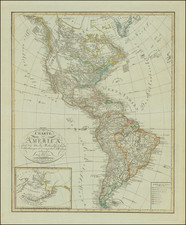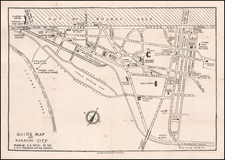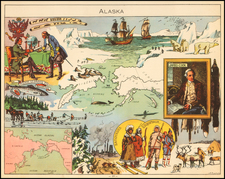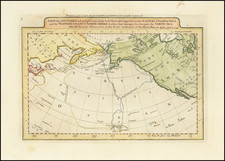A decorative and finely engraved map of Iceland, published by the Hondius family.
This engaging map shows all of the island of Iceland, dominated by a fiery volcano, while seas off of its craggy shores are inhabited by a large sea monster and icebergs. The map is based on Gerard Mercator's map of 1595, and shows that the geography of Iceland was already by this time quite well understood, as many mariners had visited its shores while taking advantage of its rich fishing grounds. At the same time, the island had an almost magical and mysterious place in the minds of contemporary Europeans. With its active volcanoes and exceptionally rough seas, many sincerely believed the land and waters to be inhabited by fierce creatures.
The map was originally published by Jodocus Hondius (1563 - 1612), a Flemish-Dutch engraver, and cartographer. He is best known for his early maps of the New World and Europe, for reinvigorating the groundbreaking work of Gerard Mercator. Critically, he helped to establish Amsterdam as the leading center of 18th Century cartography.
Hondius was born in Ghent, but left Franders to escape the religious turmoil that was affecting the region. He settled in London, and became instrumental in publicizing the work of Francis Drake, who had made a circumnavigation of the world from 1577 to 1579. In 1593, he moved to Amsterdam, capital of the flourishing Dutch Republic, where he remained until the end of his life. In co-operation with the Amsterdam publisher Cornelis Claesz., in 1604, he purchased the plates of Gerard Mercator's Atlas from Mercator's grandson. Gerard Mercator (1512-1594), found that his work had languished in comparison to that of his rival Abraham Ortelius's Theatrum Orbis Terrarum (1570). Hondius republished Mercator's work with 36 additional maps, yet honorably gave Mercator full credit as the author of the work. Hondius's new edition of Mercator's atlas was a great success, selling out after a year. Hondius later published a second edition, as well as a pocket version Atlas Minor. The maps have since become known as the "Mercator/Hondius series". Upon Hondius's death, his work was continued by his widow and two sons, Jodocus II and Henricus, and son-in-law Johannes Janssonius. The present map is from an edition of Mercator's atlas produced by his heirs.
A fine example of an important map of one of the most treasured subjects in map collecting.
Gerard Mercator is one of the most famous cartographers of all time. Mercator was born in Flanders and educated at the Catholic University in Leuven. After his graduation in 1532, Mercator worked with Gemma Frisius, a prominent mathematician, and Gaspar a Myrica, a goldsmith and engraver. Together, these men produced globes and scientific instruments, allowing Mercator to hone his skills.
With his wife, Barbara, Mercator had six children: Arnold, Emerentia, Dorothes, Bartholomeus, Rumold, and Catharina. In 1552, Mercator moved to Duisburg from Leuven, where he lived for the rest of his life. In 1564, he was appointed the official cosmographer to the court of Duke Wilhelm of Cleve.
Mercator’s most important contribution was the creation and popularization of a projection which now bears his name. On Mercator projection maps, all parallels and meridians are drawn at right angles to each other, with the distance between the parallels extending towards the poles. This allowed for accurate latitude and longitude calculation and also allowed navigational routes to be drawn using straight lines, a huge advantage for sailors as this allowed them to plot courses without constant recourse to adjusting compass readings.
Mercator’s other enduring contribution to cartography is the term “atlas”, which was first used to describe his collection of maps gathered in one volume. The Mercator atlas was published in 1595, a year after Mercator’s death, thanks to the work of his sons, particularly Rumold, and his grandsons.











![[Gansu & Ningxia] Kansu](https://storage.googleapis.com/raremaps/img/small/61498.jpg)

![[ Battle of Shanghai - Third Shanghai Expeditionary Force ] Shanghai and District 1936 Edition](https://storage.googleapis.com/raremaps/img/small/100559.jpg)
